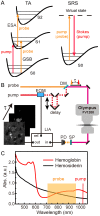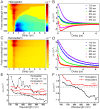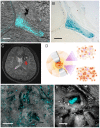Label-free imaging of hemoglobin degradation and hemosiderin formation in brain tissues with femtosecond pump-probe microscopy
- PMID: 30128041
- PMCID: PMC6096394
- DOI: 10.7150/thno.26946
Label-free imaging of hemoglobin degradation and hemosiderin formation in brain tissues with femtosecond pump-probe microscopy
Abstract
The degradation of hemoglobin in brain tissues results in the deposition of hemosiderin, which is a major form of iron-storage protein and closely related to neurological disorders such as epilepsy. Optical detection of hemosiderin is vitally important yet challenging for the understanding of disease mechanisms, as well as improving surgical resection of brain lesions. Here, we provide the first label-free microscopy study of sensitive hemosiderin detection in both an animal model and human brain tissues. Methods: We applied spectrally and temporally resolved femtosecond pump-probe microscopy, including transient absorption (TA) and stimulated Raman scattering (SRS) techniques, to differentiate hemoglobin and hemosiderin in brain tissues. The label-free imaging results were compared with Perls' staining to evaluate our method for hemosiderin detection. Results: Significant differences between hemoglobin and hemosiderin transient spectra were discovered. While a strong ground-state bleaching feature of hemoglobin appears in the near-infrared region, hemosiderin demonstrates pure excited-state absorption dynamics, which could be explained by our proposed kinetic model. Furthermore, simultaneous imaging of hemoglobin and hemosiderin can be rapidly achieved in both an intracerebral hemorrhage (ICH) rat model and human brain surgical specimens, with perfect correlation with Perls' staining. Conclusion: Our results suggest that rapid, label-free detection of hemosiderin in brain tissues could be realized by femtosecond pump-probe microscopy. Our method holds great potential in providing a new tool for intraoperative detection of hemosiderin during brain surgeries.
Keywords: hemoglobin; hemosiderin; pump-probe microscopy; stimulated Raman scattering; transient absorption.
Conflict of interest statement
Competing Interests: The authors have declared that no competing interest exists.
Figures






Similar articles
-
Resection-inspired histopathological diagnosis of cerebral cavernous malformations using quantitative multiphoton microscopy.Theranostics. 2022 Sep 11;12(15):6595-6610. doi: 10.7150/thno.77532. eCollection 2022. Theranostics. 2022. PMID: 36185604 Free PMC article.
-
Label-Free Optical Nanoscopy of Single-Layer Graphene.ACS Nano. 2019 Aug 27;13(8):9673-9681. doi: 10.1021/acsnano.9b05054. Epub 2019 Aug 5. ACS Nano. 2019. PMID: 31369704
-
Immunohistochemical assessment of ferritin in bone marrow trephine biopsies: correlation with marrow hemosiderin.Acta Haematol. 1988;80(4):194-8. doi: 10.1159/000205636. Acta Haematol. 1988. PMID: 2464264
-
Label-free brain tumor imaging using Raman-based methods.J Neurooncol. 2021 Feb;151(3):393-402. doi: 10.1007/s11060-019-03380-z. Epub 2021 Feb 21. J Neurooncol. 2021. PMID: 33611706 Free PMC article. Review.
-
Improving the accuracy of brain tumor surgery via Raman-based technology.Neurosurg Focus. 2016 Mar;40(3):E9. doi: 10.3171/2015.12.FOCUS15557. Neurosurg Focus. 2016. PMID: 26926067 Free PMC article. Review.
Cited by
-
Enhanced sciatic nerve regeneration by relieving iron-overloading and organelle stress with the nanofibrous P(MMD-co-LA)/DFO conduits.Mater Today Bio. 2022 Aug 6;16:100387. doi: 10.1016/j.mtbio.2022.100387. eCollection 2022 Dec. Mater Today Bio. 2022. PMID: 36042854 Free PMC article.
-
Label-Free Delineation of Human Uveal Melanoma Infiltration With Pump-Probe Microscopy.Front Oncol. 2022 Jul 22;12:891282. doi: 10.3389/fonc.2022.891282. eCollection 2022. Front Oncol. 2022. PMID: 35936703 Free PMC article.
-
Down syndrome with Alzheimer's disease brains have increased iron and associated lipid peroxidation consistent with ferroptosis.Alzheimers Dement. 2025 Jun;21(6):e70322. doi: 10.1002/alz.70322. Alzheimers Dement. 2025. PMID: 40536124 Free PMC article.
-
Risk factors of posthemorrhagic seizure in spontaneous intracerebral hemorrhage.Neurosurg Rev. 2025 Jan 23;48(1):76. doi: 10.1007/s10143-025-03229-2. Neurosurg Rev. 2025. PMID: 39847089 Free PMC article.
-
Resection-inspired histopathological diagnosis of cerebral cavernous malformations using quantitative multiphoton microscopy.Theranostics. 2022 Sep 11;12(15):6595-6610. doi: 10.7150/thno.77532. eCollection 2022. Theranostics. 2022. PMID: 36185604 Free PMC article.
References
-
- Hentze MW, Muckenthaler MU, Andrews NC. Balancing acts: molecular control of mammalian iron metabolism. Cell. 2004;117:285–297. - PubMed
-
- Crichton RR, Charloteaux-Wauters M. Iron transport and storage. Eur J Biochem. 1987;164:485–506. - PubMed
-
- Aisen P, Listowsky I. Iron transport and storage proteins. Annu Rev Biochem. 1980;49:357–393. - PubMed
-
- Lawen A, Lane DJ. Mammalian iron homeostasis in health and disease: uptake, storage, transport, and molecular mechanisms of action. Antioxid Redox Sig. 2013;18:2473–2507. - PubMed
-
- Weir MP, Gibson JF, Peters TJ. Haemosiderin and tissue damage. Cell Biochem Funct. 1984;2:186–194. - PubMed
MeSH terms
Substances
LinkOut - more resources
Full Text Sources
Other Literature Sources

